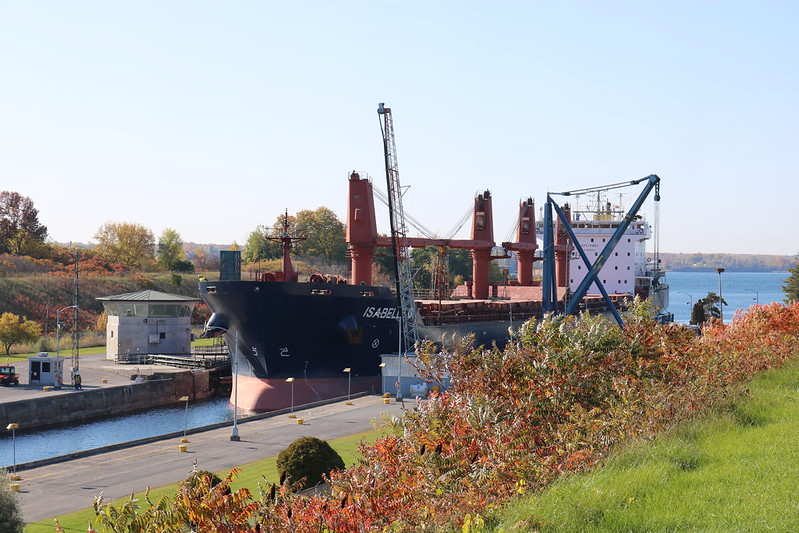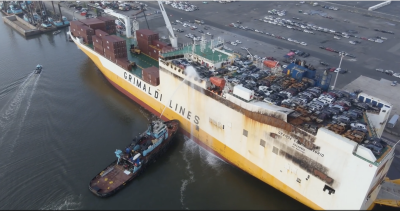Great Lakes-Seaway shipping continues to be affected by the global coronavirus pandemic.
According to the latest numbers from the St. Lawrence Seaway, tonnage through the binational transportation corridor totaled 3.9 million metric tons in July to bring the year-to-date total (from April 1 to July 31) to nearly 15.6 million metric tons, or just less than 8% below a year ago.
Year-to-date shipments of iron ore (down 13%), coal (down 16%), dry bulk (down 12%) and liquid bulk (down 20%) were offset in part by a strong showing in binational grain (up 6.7%) and general cargo like wind turbines (up 4%).
“It’s good to see overall grain shipments up, thanks mainly to strong Canadian grain exports. We are optimistic that grain shipments, both Canadian and U.S., will have a significant impact in the coming months as the 2020 crops come in,” Bruce Burrows, president and CEO of the Chamber of Marine Commerce, said in a statement announcing the latest numbers. “But the Great Lakes-Seaway shipping industry has lost a lot of ground due to the pandemic and continued decreases in areas like dry bulk and iron ore are a reflection of the economy not yet being back up to speed. The recent uptick in the auto industry could help in the months ahead.”
Climbing from Covid-19-induced lows in May, Port of Duluth-Superior tonnage totals continued a summer rebound in July. Three of the port’s four major bulk cargos registered month-over-month gains in July, with grain jumping 54% from June, coal increasing 49% and iron ore up as well. Despite those gains, total tonnage for the Port of Duluth-Superior’s season remains 29% behind last year’s pace and the five-season average.
“It’s an old adage, but lost time can’t be made up on the Great Lakes, and we’re seeing that reflected in the port’s 2020 tonnage totals,” said Deb DeLuca, executive director of the Duluth Seaway Port Authority. “With that said, it’s good to see the month-over-month improvements, and hopefully the initial indications of a production rebound.”
For the Port of Toledo, cargo tonnage remains approximately 15% behind the 2019 cargo tonnage totals. Coal, grain and dry bulk cargo levels were all over 20% lower than last year while general cargo and liquid bulk products outpaced last year.
“While the season is down compared to last year, it’s still very important to keep things in perspective,” said Joseph Cappel, vice president of business development for the Toledo-Lucas County Port Authority. “More than 3.8 million tons of cargo have been handled on 210 vessel calls through July in the Port of Toledo. The impact of moving all that cargo via marine transportation provides savings for shippers through economies of scale at a time when they need those savings the most.”
Cappel adds that the marine mode also minimizes the environmental impact of moving bulky products great distances into the interior of the U.S. and Canada via the Great Lakes–St. Lawrence Seaway System.
Meanwhile, the Port of Green Bay, Wis., saw tonnage taper off in July following a relatively strong start to the 2020 shipping season. “Through June we were pretty much on pace with last year, which was a very good year for the Port of Green Bay,” said Dean Haen, port director. “The decline in July was primarily due to drops in imports of petroleum products and salt.”
Nearly 170,000 tons of cargo was shipped through the Port of Green Bay in July, bringing the year-to-date total to 907,697 tons. That’s a decline of about 10% compared to 2019, which was a strong shipping season in Green Bay.
“This has certainly been a difficult year to accurately forecast shipping levels,” Haen added. “The impact of Covid-19 is being felt throughout the Great Lakes and beyond. But we remain cautiously optimistic for a good finish for the remainder of the 2020 shipping season.”




.png.small.400x400.png)
